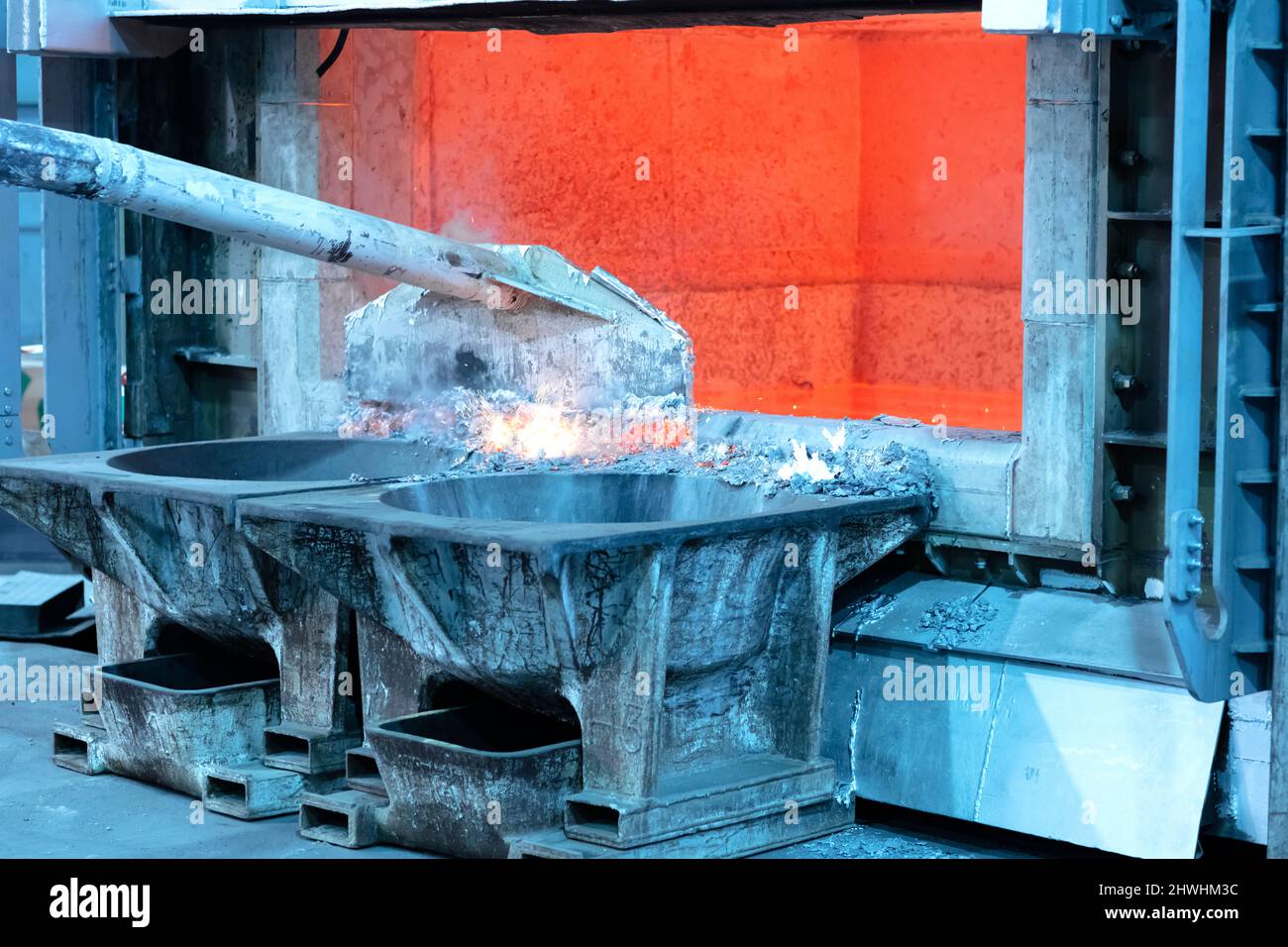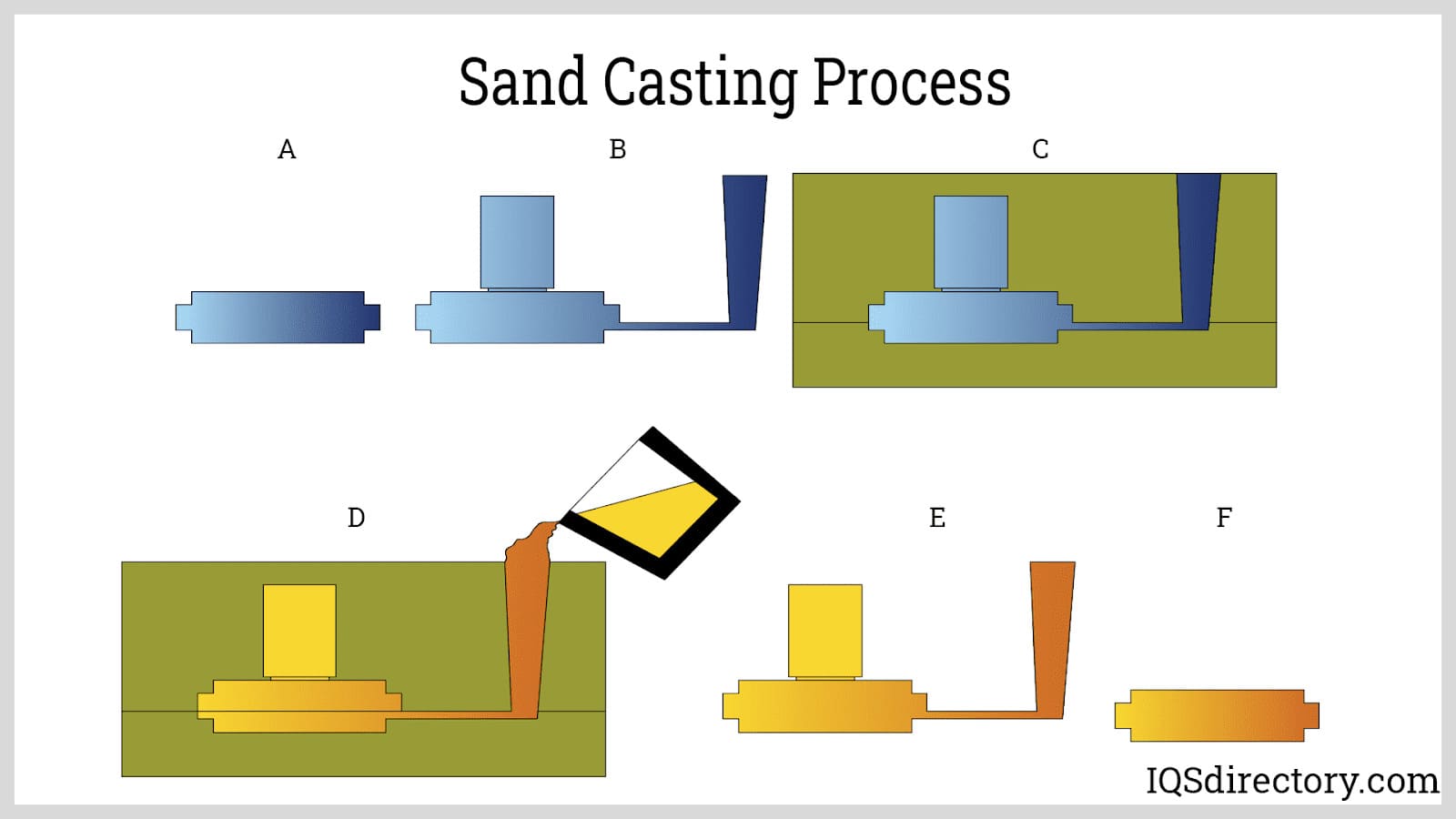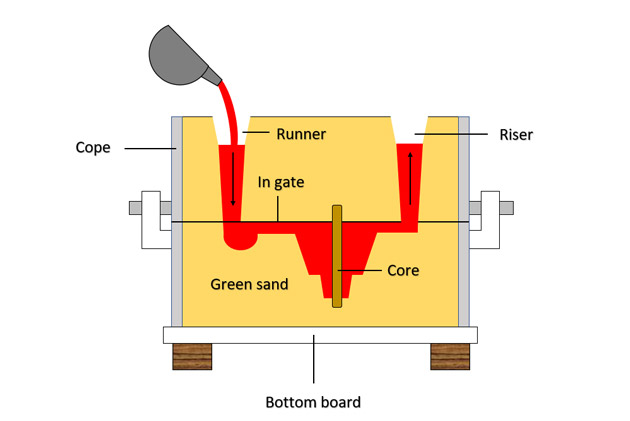Highlighting Aluminum Foundry Wisconsin for manufacturing casting needs
A Comprehensive Overview to the Techniques Utilized in Aluminum Foundry Procedures
Aluminum Foundry operations utilize numerous casting techniques, each with unique procedures and applications. Recognizing these methods is essential for enhancing manufacturing and achieving desired product homes. From sand spreading to pass away spreading, the choices available can significantly influence performance and cost. As technology advances, so as well do these techniques, triggering a more detailed evaluation of their constraints and benefits. The effects of these advancements necessitate further expedition.
Summary of Aluminum Spreading Techniques
Aluminum spreading strategies include a variety of techniques utilized to shape liquified Aluminum into preferred forms. These techniques are essential in the manufacturing and engineering fields, supplying adaptability and performance. Major strategies consist of pass away spreading, which uses high-pressure to inject Aluminum into molds for accuracy parts, and gravity spreading, where molten Aluminum is put into molds under the influence of gravity, permitting bigger, less intricate forms. Financial investment casting, one more method, includes producing a wax pattern coated in ceramic, providing high dimensional accuracy for detailed designs. Additionally, permanent mold spreading uses recyclable mold and mildews, improving manufacturing performance and minimizing waste. Each method accommodates certain applications, balancing aspects such as price, production volume, and product residential properties. As markets develop, improvements in these casting techniques remain to enhance the quality and performance of Aluminum elements, positioning them as crucial procedures within modern production.
Sand Spreading: Refine and Applications
Sand spreading is a widely made use of approach in the Foundry sector, understood for its simplicity and adaptability. Aluminum Foundry. This procedure includes developing a mold and mildew from a combination of sand and a bonding representative, usually clay. The mold is formed around a pattern, which is a reproduction of the desired last product. Once the mold and mildew is prepared, molten Aluminum is poured right into the dental caries, allowing it to solidify into the desired form
Among the primary advantages of sand spreading is its capacity to create large elements and complex geometries, making it suitable for various applications, consisting of automotive parts, equipment components, and ornamental things. Additionally, sand spreading can suit various Aluminum alloys, improving its convenience. The procedure is affordable for reduced to tool manufacturing runs, as it does not need pricey tooling. In general, sand casting stays a basic technique in Aluminum Foundry operations due to its effectiveness in meeting diverse production demands.
Pass Away Spreading: Advantages and Limitations
While die casting is commonly contrasted to sand casting, it provides distinct benefits and constraints that make it ideal for certain applications in the Aluminum Foundry market. One significant advantage of die spreading is its capacity to create complicated shapes with high dimensional precision and superb surface finish. This procedure is especially helpful for mass production, as it allows for faster cycle times and reduced labor prices. Furthermore, die casting decreases product waste, enhancing total effectiveness.
Die spreading likewise has constraints. The preliminary tooling costs are reasonably high, making it less viable for tiny production runs. Furthermore, the procedure is finest matched for metals with reduced melting points, which can limit material options. Pass away spreading is likewise minimal relating to the optimum size of the components produced, as bigger components may call for alternate techniques. Stabilizing these elements is vital for figuring out the appropriate application of die casting in the Aluminum Foundry market.
Investment Casting: Accuracy and Information
Financial investment casting is an extremely exact production process that enables complex layouts and great details in Aluminum components. This method uses substantial advantages, including improved dimensional accuracy and minimized machining needs. Its applications extend various industries, highlighting its flexibility and efficiency in generating intricate components.
Refine Overview
The investment spreading process is renowned for its capacity to generate high-precision parts and intricate forms. This technique begins with creating a wax pattern, which is then coated with a ceramic shell. Once the shell solidifies, the wax is thawed away, leaving a precise cavity for the liquified steel. The Aluminum is put into this tooth cavity, capturing the fine information of the initial pattern. After cooling, the ceramic shell is broken away, disclosing the actors part. Any type of needed completing work, such as machining or surface area therapy, is done to accomplish the desired specifications. This procedure is specifically helpful for complex geometries that are difficult to attain via standard casting techniques, ensuring both quality and precision in the final product.
Benefits of Precision
Precision in financial investment spreading uses considerable benefits, making it a favored option for making complex components. This method enables the production of complex forms with tight resistances, reducing the requirement for extensive machining and decreasing product waste. The capability to accomplish high dimensional accuracy equates to an exceptional fit and surface, enhancing the overall quality of the last item. Furthermore, financial investment spreading permits for the unification of great details, which is crucial for components requiring elaborate designs. The procedure additionally supports the usage of various Aluminum alloys, even more expanding its applicability. On the whole, the accuracy offered by investment spreading not just boosts the aesthetic and practical characteristics of components yet also adds to enhanced efficiency in manufacturing cycles.
Applications in Sector
While lots of manufacturing procedures exist, financial investment spreading attracts attention for its adaptability throughout numerous sectors, specifically in industries requiring high precision and thorough parts. This casting technique is commonly utilized in aerospace, automobile, and clinical fields, where elaborate layouts and limited tolerances are crucial. Aerospace elements benefit from investment spreading's capability to generate intricate geometries that minimize weight without compromising structural honesty. The automotive sector utilizes this technique to make engine parts that call for toughness and precision. In the clinical market, investment spreading enables the manufacturing of surgical tools and implants that should meet rigid quality criteria. In general, financial investment casting greatly improves product performance and integrity, making it a very useful method in modern-day manufacturing applications.
Contrast of Casting Approaches
 The contrast of casting approaches discloses distinctive benefits and applications throughout different methods - Aluminum Foundry. Sand casting is frequently celebrated for its flexibility and cost-effectiveness, while die spreading is identified for its performance and precision in producing high quantities. Investment spreading, previously talked about, showcases its distinct ability to create detailed styles, even more emphasizing the varied abilities of each technique in Aluminum Foundry operations
The contrast of casting approaches discloses distinctive benefits and applications throughout different methods - Aluminum Foundry. Sand casting is frequently celebrated for its flexibility and cost-effectiveness, while die spreading is identified for its performance and precision in producing high quantities. Investment spreading, previously talked about, showcases its distinct ability to create detailed styles, even more emphasizing the varied abilities of each technique in Aluminum Foundry operationsSand Spreading Advantages
Sand casting offers numerous advantages when compared to various other casting techniques, making it a preferred selection in different production applications. Among the main benefits is its affordable, as the materials needed, such as sand and metal, are low-cost and readily offered. Additionally, sand spreading enables better style adaptability, allowing the manufacturing of complex forms and large elements that might be challenging to attain with other methods. The process likewise suits a wide variety of metal alloys, including Aluminum, boosting its flexibility. In addition, sand molds can be quickly fixed or modified for subsequent casts, making it reliable for both big and tiny production runs. Overall, these advantages add to sand spreading's appeal in the Foundry industry.
Die Casting Techniques
Die spreading strategies stand out as an extremely effective approach for generating steel components, particularly when compared to conventional Your Domain Name casting techniques like sand spreading. This procedure entails compeling liquified Aluminum right into a mold and mildew under high stress, causing specific measurements and a smooth surface area coating. Unlike sand spreading, which calls for considerable ending up job, pass away casting decreases post-production webpage handling, boosting general efficiency. Furthermore, die casting can accommodate complex geometries, permitting detailed layouts that would certainly be testing to accomplish through other methods. The rate of manufacturing is one more advantage; die spreading can create big quantities of components in a much shorter timeframe. In general, the mix of efficiency, layout, and precision adaptability makes pass away casting a preferred selection in modern-day Aluminum Foundry operations.
Financial Investment Casting Applications
Investment spreading, frequently referred to as lost-wax spreading, offers distinct benefits over various other casting methods, especially relative to accuracy and surface finish. This method enables the production of intricate shapes and fine details that are tough to attain with sand or pass away spreading. Additionally, investment casting produces components with exceptional dimensional precision, minimizing the demand for extensive machining. Its versatility makes it suitable for various industries, including aerospace, automotive, and medical devices, where premium elements are vital. Compared to die casting, which can be limited by mold intricacy, financial investment spreading masters creating complicated geometries without compromising structural honesty. The option of investment casting comes to be significantly positive for applications demanding high performance and integrity.
High Quality Control in Aluminum Foundry Workflow
How can Aluminum shops ensure the best in their items? Executing strenuous top quality control steps is essential. Shops normally begin by developing clear specifications for the Aluminum alloys made use of, ensuring they meet sector requirements. Continual tracking throughout the melting and pouring procedures helps recognize any inconsistencies from preferred chemical make-ups.
Visual examinations and non-destructive testing techniques, such as ultrasonic or X-ray exams, are commonly utilized to identify internal problems or incongruities in spreadings. Additionally, statistical procedure control strategies track manufacturing data, enabling for early recognition of possible concerns.
Normal training and accreditation of workers in quality control practices are vital for maintaining high requirements. Implementing feedback loopholes from consumers can aid shops improve their procedures and boost item high quality. By sticking to these methods, Aluminum factories can constantly provide top notch items that satisfy or surpass consumer assumptions.
Future Patterns in Aluminum Casting Technology
Advancements in Aluminum spreading modern technology are poised to reshape the sector landscape, structure upon well established quality assurance practices. Technologies such as additive production and wise Foundry solutions are arising, allowing improved design adaptability and decreased waste. The integration of fabricated knowledge and artificial intelligence in procedure monitoring enables real-time modifications, improving performance and product top quality.
Sustainability stays a key focus, with a focus on recycling scrap Aluminum and reducing energy intake. Advanced alloy formulas are being developed to enhance efficiency while reducing environmental effect. The fostering of automated systems, including robotics for putting and handling, guarantees to enhance work environment safety and security and precision.
Electronic twins are acquiring grip, permitting for virtual simulations that assist in far better decision-making and predictive maintenance. As these patterns progress, they will likely develop a more efficient, sustainable, and technically progressed Aluminum spreading industry, setting new standards for high quality and efficiency.
Regularly Asked Inquiries
What Safety Steps Should Be Taken in Aluminum Foundry Workflow?
In Aluminum Foundry operations, necessary precaution include personal protective equipment, proper ventilation, regular training, risk evaluations, emergency preparedness, and adherence to protocols to reduce risks related to molten metal and hefty equipment.
Just How Is Recycled Aluminum Made Use Of in Foundry Processes?
Recycled Aluminum is frequently used in Foundry processes to decrease environmental impact and manufacturing prices. It undertakes melting and refining, enabling makers to produce top quality products while preserving power and lessening waste in the Aluminum lifecycle.
What Devices Is Important for Aluminum Casting?
Crucial tools for Aluminum casting includes heaters for melting, mold and mildews for shaping, pouring ladles, cooling down systems, and completing devices. Each part plays an important function in making certain the performance and top quality of the spreading process.
How Do Ecological Regulations Influence Aluminum Foundries?
Environmental regulations substantially affect Aluminum foundries by enforcing limits on exhausts and waste administration. Conformity requires financial investment in cleaner innovations, which can raise operational prices however inevitably promotes sustainability and lowers the environmental impact of the industry.

What Prevail Problems in Aluminum Castings and Their Solutions?
Common problems in Aluminum castings consist of surface area, shrinking, and porosity imperfections. Solutions involve maximizing thaw high quality, controlling cooling click for more info prices, and utilizing proper mold layout, making certain far better stability and performance of the last actors products.
 Significant strategies include die casting, which uses high-pressure to infuse Aluminum into molds for precision components, and gravity spreading, where molten Aluminum is put right into mold and mildews under the influence of gravity, allowing for larger, less complicated forms. While die spreading is often compared to sand casting, it uses distinctive benefits and constraints that make it ideal for specific applications in the Aluminum Foundry industry. Sand casting is typically celebrated for its versatility and cost-effectiveness, while die spreading is acknowledged for its effectiveness and accuracy in creating high quantities. Die casting methods stand out as an extremely effective technique for generating metal components, specifically when contrasted to typical spreading approaches like sand spreading. Compared to die casting, which can be restricted by mold and mildew intricacy, investment casting excels in generating intricate geometries without endangering architectural stability.
Significant strategies include die casting, which uses high-pressure to infuse Aluminum into molds for precision components, and gravity spreading, where molten Aluminum is put right into mold and mildews under the influence of gravity, allowing for larger, less complicated forms. While die spreading is often compared to sand casting, it uses distinctive benefits and constraints that make it ideal for specific applications in the Aluminum Foundry industry. Sand casting is typically celebrated for its versatility and cost-effectiveness, while die spreading is acknowledged for its effectiveness and accuracy in creating high quantities. Die casting methods stand out as an extremely effective technique for generating metal components, specifically when contrasted to typical spreading approaches like sand spreading. Compared to die casting, which can be restricted by mold and mildew intricacy, investment casting excels in generating intricate geometries without endangering architectural stability.